Nova Scotia, Canada
Sphingidae
Amphion floridensis, Round Hill, N.S., June 2, 2010, courtesy of Bev Wigney.
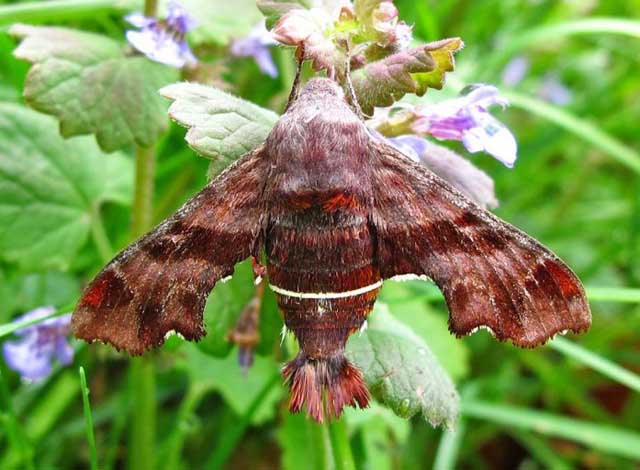
Amphion floridensis, Round Hill, N.S., June 2, 2010, courtesy of Bev Wigney.
Derek and I have also been making an annual collecting trip to Malay Falls in late June, and I have personally seen many of these species at our light set ups.
This page is dedicated to Derek Bridgehouse and the many other residents and visitors to Nova Scotia who have sent me images and or data.
In June 2010 Chris Majka sends the following email:
"I don't know if you are aware, however, in Ferguson (1955) four additional species of Sphingidae are reported from Nova Scotia including:
Aellopos tantalus (Linnaeus) – [Sydney from the 1890's; there is some question about this specimen]
"The first two would appear to be non-resident migrants, but Hyles lineata (Fabricius) is a resident species and
the Eumorpha pandorus was found associated with Ampelopsis in NS, so at least that individual seems to have bred here.
"Also Wright (1989) recorded Xylophanes tersa (Linnaeus) on Sable Island; another, a vagrant sub-tropical migrant."
Eumorpha fasciatus (Sulzer) – [Musquodoboit, McNab's Island, Granville Ferry]
Eumorpha pandorus (Hübner) – [Armdale]
Hyles lineata (Fabricius) – [McNab's Island, Digby]
Chris adds, "I'm sure Aellopos tantalus (Linnaeus), Eumorpha fasciatus (Sulzer), and Eumorpha pandorus (Hübner) are all irregular vagrants. I don't know if Hyles lineata (Fabricius) can/does overwinter. Ferguson noted that he examined a number of specimens collected in Digby by John Russell (his collection is now at the CNC) so there's some indication that it appeared there on a regular basis. I'm not sure when Russell collected (1930's?) and I'm not aware of recent records in NS, but on the other hand, I don't know that anyone has looked at sphinx moths in the Digby area for decades."
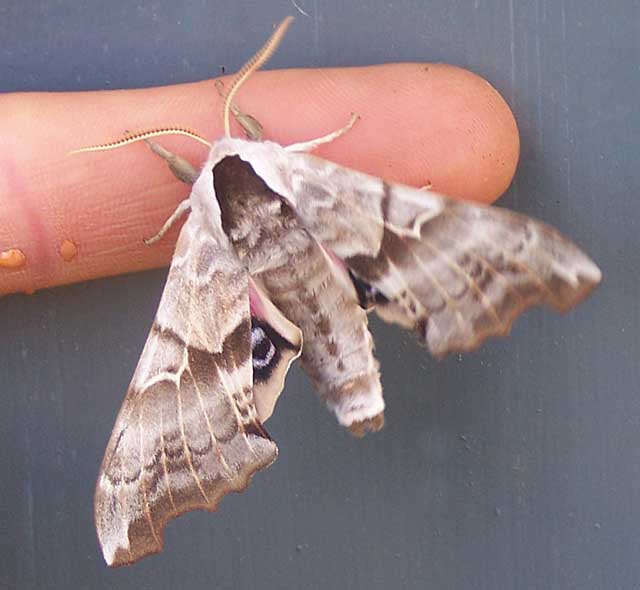
Smerinthus cerisyi male, Annapolis Royal, Nova Scotia,
late May, 2010, courtesy of Angelika Waldow.
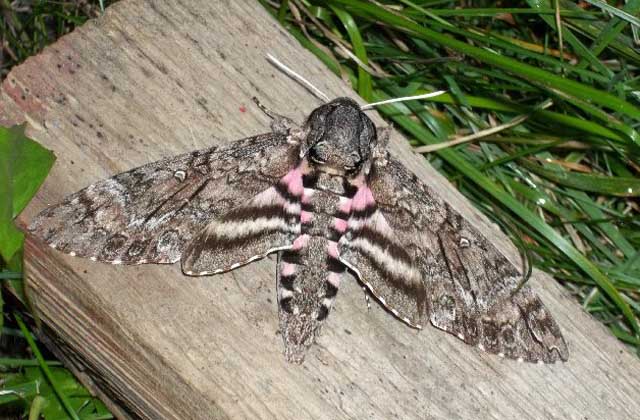
Agrius cingulata, Sydney, Cape Breton Island, Nova Scotia,
September 30, 2012, courtesy of Lorna MacLean.
Many thanks to Helen Tyson who provides the following image.
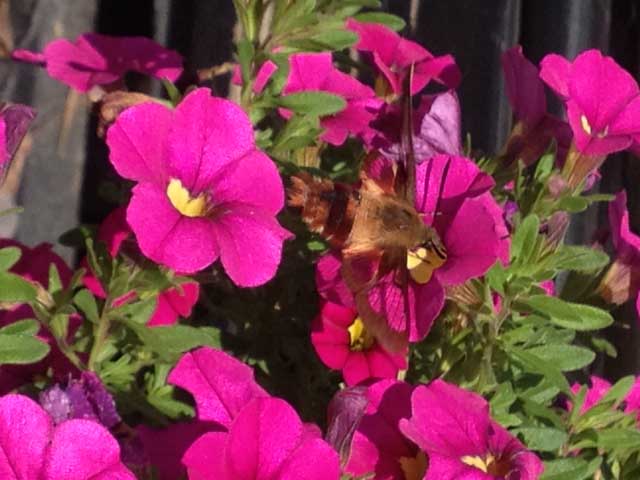
Hemaris thysbe, Parrsboro, Nova Scotia,
August 1, 2014, courtesy of Helem Tyson.
Many thanks to Krista Melville who has sent me images in 2017-2018.
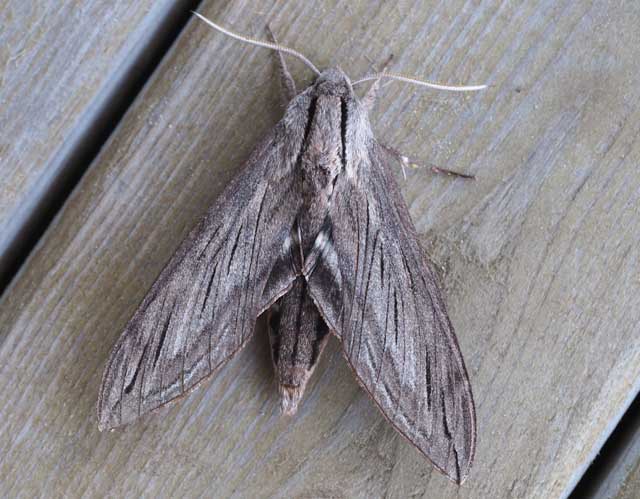
Sphinx chersis, Hammonds Plains, Nova Scotia,
July 28, 2017, Krista Melville.
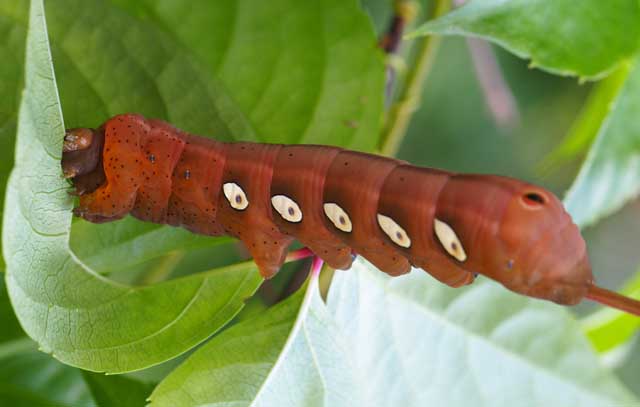
Sphinx chersis, Canning, Nova Scotia,
August 28, 2017, Krista Melville.
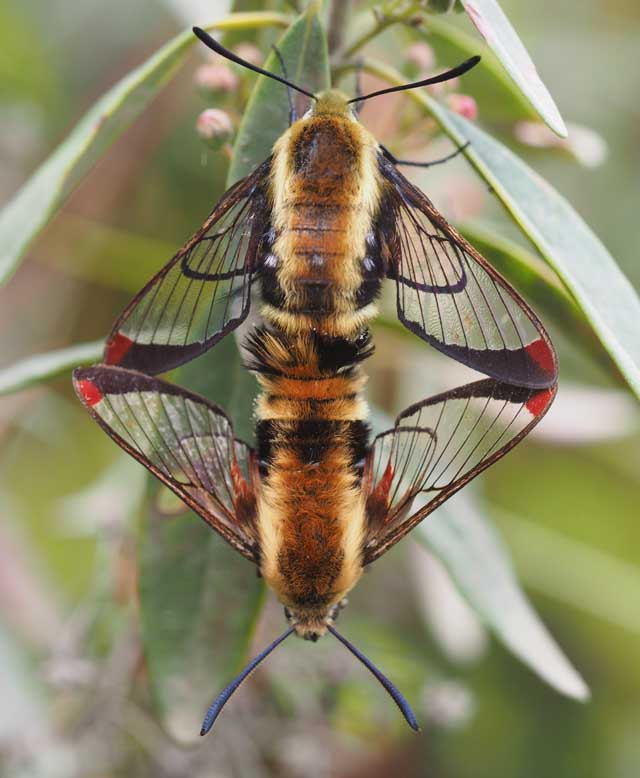
Hemaris aethra in copula, Hammonds Plains, Nova Scotia,
June 21, 2018, courtesy of Krista Melville
Sphinginae subfamily
|
 | Agrius cingulatastray, Pink-spotted Hawkmoth strayThis moth is a very strong flier, but would only make its way to Nova Scotia as a rare stray, usually in fall, assisted by strong southerly winds. |
 | Ceratomia amyntor, the Elm Sphinx or Four-horned SphinxThe upperside of the forewing is brown with dark brown and white markings including a white costal area near the wing base, dark streaks along the veins, and a white spot in the cell. |
 | Ceratomia undulosa, the Waved SphinxThe upperside of the forewing is pale brownish gray with wavy black and white lines and a black-outlined white cell spot. The upperside of the hindwing is gray with diffuse darker bands. |
 | Dolba hyloeus, the Pawpaw SphinxThe upperside of the forewing is dark brown with a dusting of white scales. Some moths have patches of reddish or yellowish brown on the wings. unlikely possibility; but confirmed by Derek Bridgehouse, June 2020 |
 | Lapara bombycoides, the Northern Pine SphinxIf you have pines, you probably have this species. It flies on P.E.I. |
 | Manduca quinquemaculatus, the Five-spotted Hawkmoth. The moth abdomen usually has five but sometimes six pairs of yellow bands. The upperside of the forewing is blurry brown and gray. I suspect if you grow tomatoes, you are likely to encounter it. |
 | Paratrea plebeja, the Plebeian SphinxThe upperside of the forewing is gray with indistinct black and white markings. There is a series of black dashes from the base to the tip, and a small white cell spot. unlikely possibility |

| Sphinx canadensis probably present, Sphinx canadensis, the Canadian Sphinx, is not common, and is not often reported anywhere, but it might be present.Larval hosts are white ash (Fraxinus americana) and blueberry (Vaccinium). |
 | Sphinx chersis, the Northern Ash Sphinx or Great Ash Sphinx. This species is present and is probably common. Larval hosts are ash, lilac, privet, cherry, and quaking aspen. |
 | Sphinx drupiferarum abundant, the Wild Cherry Sphinx
This species is officially reported in Ontario. We have them on P.E.I., but I do not see them nearly as frequently as I see the other Sphingidae. |
Sphinx drupiferarum, Mt Uniacke, July 19, 2019, Derek Bridgehouse
 | Sphinx gordius probably poecila, the Apple SphinxThe upperside of the forewing ranges from brown with black borders through brownish gray with paler borders to pale gray with no borders. probably poecila in Nova Scotia |
 | Sphinx kalmiae present, the Laurel SphinxThe lower forewings are predominantly brownish-yellow with a fairly wide dark bar along the inner margin. At rest the wings hug the body, giving the moth a long slender look. |
 | Sphinx luscitiosa present, the Canadian Sphinx or Clemen's SphinxThis one is reported from Ontario, but it is generally not common. |
 | Sphinx poecila abundant, the Poecila SphinxIf you have blueberries in the woods, then you might have the Poecila Sphinx. They are pretty common here on Prince Edward Island. |
 | Amorpha juglandis common, the Walnut SphinxThe adults are also highly variable; sometimes wings of an individual may be all one color or may have several colors, ranging from pale to dark brown, and may have a white or pink tinge. See the file for the female; she is different. |
 |
Pachysphinx modesta
common,
the Modest Sphinx or Poplar Sphinx |
 | Paonias excaecata common, the Blinded Sphinx
Named for the dull grey-blue spot (minus dark pupil) in the hindwing,
this moth has a wide distribution and is common in Ontario.
|
 | Paonias myops, the Small-eyed SphinxNamed for the small eye-spot in the hindwing, this moth has a wide distribution and is probably common in Ontario. I regularly see them on Prince Edward Island, and they are reported as far south as Florida. |
 |
Smerinthus cerisyi
common,
the Cerisyi's Sphinx |
 | Smerinthus jamaicensis common, the Twin-spotted Sphinx. This moth is widely distributed and fairly common. Along the East Coast, it flies from P.E.I. to Florida. I suspect it is present. |
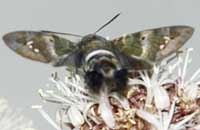 | Aellopos tantalus CM/questionable, Tantalus Sphinx. The body is reddish brown with a wide white band across the abdomen. The forewing upperside is reddish brown with a black cell spot and 3 white spots near the gray marginal area. A pale streak runs from the cell spot to the inner margin of the wing. |
 | Hemaris thysbe common, Hummingbird Clearwing. It is not difficult to see why many gardeners would mistake an Hemaris thysbe moth for a small hummingbird as it hovers, sipping nectar from flowers through a long feeding tube. |
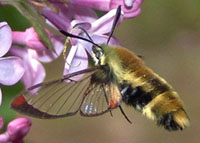 | Hemaris aethra common. Note large orangey-brown forewing apical patch. In very similar H. diffinis patch is smaller. On average H. aethra, compared to H. diffinis, tends to be slightly larger, with more orangey-yellow tone, less tapering (top to bottom) of dark thorax/abdominal region; more red nr hw anal angle. |
 |
Hemaris diffinis common,
Snowberry Clearwing or Bumblebee Moth |
 | Hemaris gracilis present, the Slender Clearwing or Graceful ClearwingThis day-flying moth is less common. |
 |
Eumorpha fasciatus
CM, the Banded Sphinx |
 | Eumorpha pandorus CM, the Pandorus SphinxIf you have Grape or Virginia Creeper nearby, then you probably have this species. I often get asked to identify larvae from areas not previously reported. Armdale, Nova Scotia. probably?? does not overwinter; many larval sightings suggest otherwise |
Eumorpha pandorus final instar on Virginia Creeper, Canning, Nova Scotia, August 26, 2017, Krista Melville.
Eumorpha pandorus final instar, Canning, Nova Scotia, August 28th, 2017, Krista Melville.
 | Amphion floridensis common, the Nessus Sphinix
This day flier is widely distributed. If you have Virginia Creeper,
you probably have the Nessus Sphinx. It is officially reported
from Ontario. |
 | Darapsa choerilus common, the Azalea SphinxThey are common in New Jersey and common here on Prince Edward Island.
You will often see this species listed as Darapsa pholus,
especially in older literature. |
 | Hyles gallii present, the Bedstraw Hawk Moth or Gallium SphinxThis species is reported in Ontario. Some years I see them on P.E.I., some years, I do not. |
 | Hyles lineata CM, the White-lined Sphinx. This species is officially reported from Digby by John Russell. It is a strong migrator from the south. McNab's Island, Digby. probably does not overwinter |
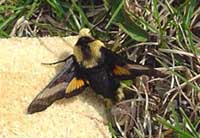 | Proserpinus flavofasciata present, the Yellow-banded Day SphinxThis day flier is officially reported from Ontario, but it maynot be common. Look for them in meadows near coniferous forests. |
 | Xylophanes tersa CM, the Tersa SphinxThis moth is much more common to the south. It is a strong migrant, however, and is probably only present as a rare stray. |
Enjoy some of nature's wonderments, giant silk moth cocoons. These cocoons are for sale winter and fall. Beautiful Saturniidae moths will emerge the following spring and summer. Read Actias luna rearing article. Additional online help available.
Eggs of many North American species are offered during the spring and summer. Occasionally summer Actias luna and summer Antheraea polyphemus cocoons are available. Shipping to US destinations is done from with in the US.
Use your browser "Back" button to return to the previous page.
This page is brought to you by Bill Oehlke and the WLSS. Pages are on space rented from Bizland. If you would like to become a "Patron of the Sphingidae Site", contact Bill.
Please send sightings/images to Bill. I will do my best to respond to requests for identification help.
 Show appreciation for this site by clicking on flashing butterfly to the left. The link will take you to a page with links to many insect sites. |
I very much appreciate all the many images that have been sent to me, or of which I have been granted permission to copy and post from other websites. All images on this site remain the property of respective photographers.
If you would like to contribute to the maintenance of this website by sending a contribution to
Bill Oehlke
Box 476
155 Peardon Road
Montague, Prince Edward Island, C0A1R0
Canada
your donation would be much appreciated and would be used for
1) paying for webspace rental;
2) paying for computer maintenance and software upgrades;
3) purchases of additional text reference material (journals and books) in an effort to stay current with new species;
4) helping to pay my daughter's tuition (completed spring of 2013).
I also hope to expand the North American Catocala site as well as the Sphingidae of the Americas site, to worldwide sites, and that will require additional funds for reference materials, etc. Both of those site are linked from your WLSS homepage.
If you are mailing a check from USA, please use $0.85 postage ($1.25 is 2018 rate so check with post office as rates seem to be increasing almost annually). Donations can also be made through Paypal via the button below.
Donations are not required to maintain your standing as a WLSS member, nor do they gain you any preferencial treatment with regard to livestock and/or supplies (sleeves), compared to other WLSS members. All WLSS members get first crack at my annual offerings and get an approximate discount of 10% as compared to non-members.
I do usually ask donors if they have any special requests for material on WLSS, and I try to accomodate when appropriate or within my ability to do so.